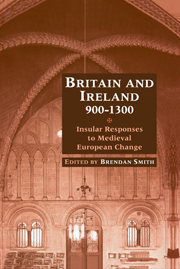Book contents
- Frontmatter
- Contents
- Contributors
- Preface
- List of abbreviations
- 1 The effect of Scandinavian raiders on the English and Irish churches: a preliminary reassessment
- 2 The changing economy of the Irish Sea province
- 3 Cults of Irish, Scottish and Welsh saints in twelfth-century England
- 4 Sea-divided Gaels? Constructing relationships between Irish and Scots c. 800–1169
- 5 The 1169 invasion as a turning-point in Irish-Welsh relations
- 6 Killing and mutilating political enemies in the British Isles from the late twelfth to the early fourteenth century: a comparative study
- 7 Anglo-French acculturation and the Irish element in Scottish identity
- 8 John de Courcy, the first Ulster plantation and Irish church men
- 9 Coming in from the margins: the descendants of Somerled and cultural accommodation in the Hebrides, 1164–1317
- 10 Nobility and identity in medieval Britain and Ireland: The de Vescy family, c. 1120–1314
- Bibliography
- Index
5 - The 1169 invasion as a turning-point in Irish-Welsh relations
Published online by Cambridge University Press: 30 July 2009
- Frontmatter
- Contents
- Contributors
- Preface
- List of abbreviations
- 1 The effect of Scandinavian raiders on the English and Irish churches: a preliminary reassessment
- 2 The changing economy of the Irish Sea province
- 3 Cults of Irish, Scottish and Welsh saints in twelfth-century England
- 4 Sea-divided Gaels? Constructing relationships between Irish and Scots c. 800–1169
- 5 The 1169 invasion as a turning-point in Irish-Welsh relations
- 6 Killing and mutilating political enemies in the British Isles from the late twelfth to the early fourteenth century: a comparative study
- 7 Anglo-French acculturation and the Irish element in Scottish identity
- 8 John de Courcy, the first Ulster plantation and Irish church men
- 9 Coming in from the margins: the descendants of Somerled and cultural accommodation in the Hebrides, 1164–1317
- 10 Nobility and identity in medieval Britain and Ireland: The de Vescy family, c. 1120–1314
- Bibliography
- Index
Summary
It goes virtually without saying that the arrival in Ireland in the late 1160s of the first smallish contingents of Anglo-Norman adventurers and mercenaries marks a turning-point of some sort in the history of Ireland's relationship with Wales. Frequently the invaders had cut their teeth in Wales, many had won estates in Wales or in the Welsh marches and some had found wives there. They brought with them to Ireland, and employed in their wars against the Irish, valuable experience gained in comparable warfare against the Welsh. They countered Irish arms with bands of Welsh archers and colonized their newly acquired swordland with ship-loads of tenants from their Welsh and Marcher lordships, some of whom were undoubtedly of native Welsh extraction.
The invasion established, therefore, a new nexus of involvement between Ireland and Wales, which interrupted, though it certainly did not obliterate, earlier patterns of contact between the two countries. This operated at different levels – ecclesiastical and scholarly, political and military, commercial – and also, and equally significantly, with different degrees of intensity. For instance, if one were to draw a line on a map of Ireland running from Galway to Dundalk, the evidence would indicate that the area north of that line, as geography if nothing else dictated, had long-established lines of communication with northern Britain and was by comparison relatively isolated from contact with Wales.
- Type
- Chapter
- Information
- Britain and Ireland, 900–1300Insular Responses to Medieval European Change, pp. 98 - 113Publisher: Cambridge University PressPrint publication year: 1999
- 1
- Cited by

